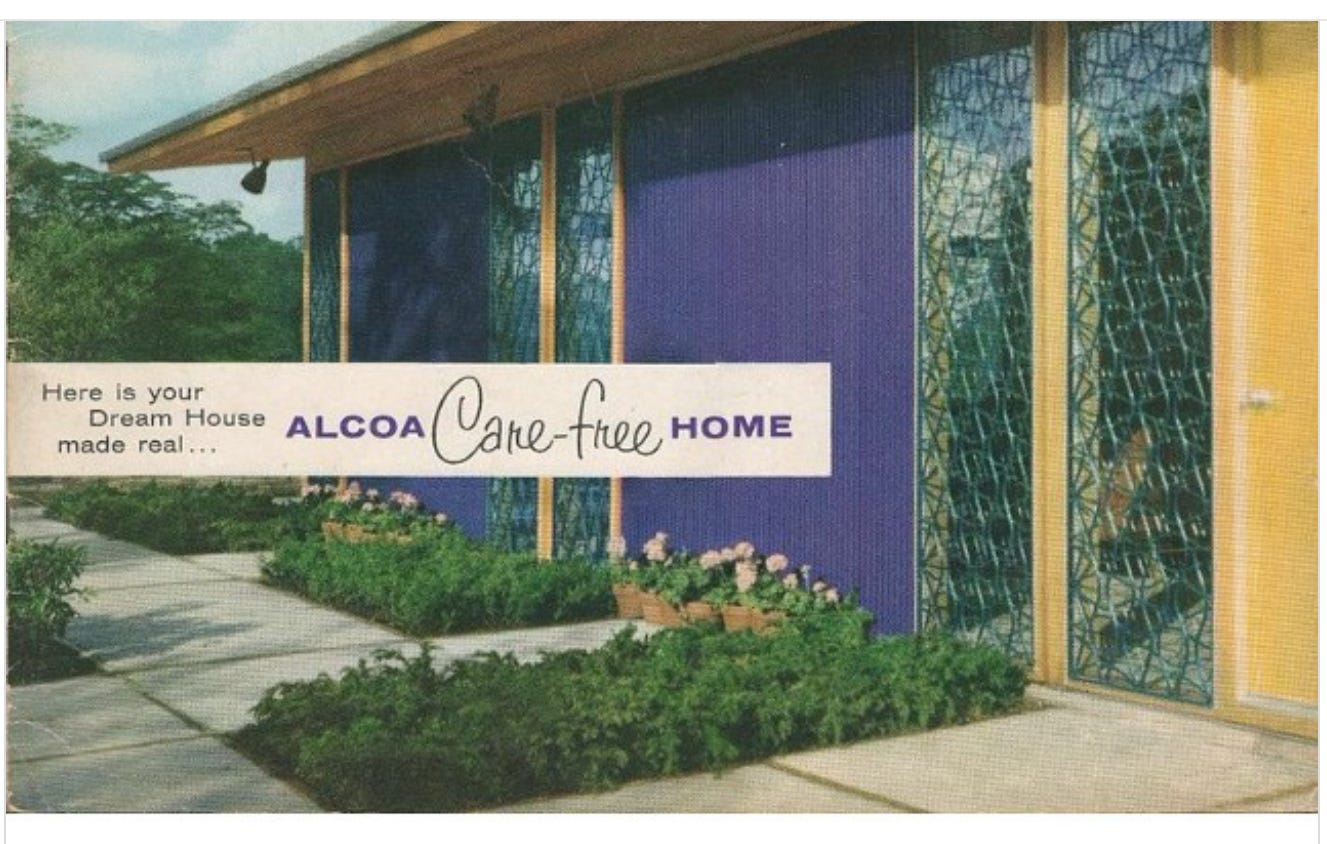Alcoa Care Free Homes were mid-century suburban homes designed for Alcoa Aluminum Company by architect Charles M. Goodman. The concept was that a full home was produced by Alcoa and shipped to local sites, then installed by local general contractors. They first emerged in 1957, intending to supply one home per state.
This was not an entirely new idea. Sears had sold “kit homes” beginning in 1908.
We are able to gather a wealth of information on Alcoa homes at myalcoanome.com
In the 1950s, 24 Alcoa Care-Free Homes were built in 16 states: Colorado, Connecticut, Florida, Illinois, Indiana, Massachusetts, Michigan, (2), Minnesota, New York, Ohio, Oregon, Pennsylvania, Tennessee, Texas, Virginia, and Washington.
The cost of building Care-Free Homes turned out to be more expensive than anticipated; the residential market was not ready for an innovative style that departed markedly from traditional styles, and local house builders were not willing to abandon their traditional methods. So the experiment was dropped.
In 2013 a website, midcenturymichigan.com posted this description/review of an Alcoa Care Free home still remaining in Grand Rapids, Michigan:
With a symmetrical layout, the Alcoa Care Free Home is a classic mid-century modern ranch, with large expanses of floor-to-ceiling glass capping off either end of its peaked structure. A soaring, vaulted roof clad in cypress creates a sense of vastness for the 1,900 square foot main floor, where walls of tongue-in-groove teak add a sense of warmth and enclosure to the space. Interior clerestory windows between the bedrooms and entryways achieve what Goodman described as an “atmosphere of Space.” (Exciting new ways to build with aluminum. Better Homes and Gardens, October 1957.) Throughout the home Goodman chose a playful jewel tone palette of purple, teal, green and gold. These colorful finishes are found in cabinetry, doors, paneling, and fixtures. Exposed aluminum components are both colorfully anodized and bare metallic, adding a dazzling glint to the interior.
When all was said and done, Alcoa Care Free Homes were simply too expensive for the market. The question this raises is whether or not the concept might have legs in different market conditions. For those readers in pursuit of more information on the Alcoa homes, check out the link below to a virtual tour of a renovated example in Hollin Hills, California.
Off-site built homes today
We have had a quick review of the Sears and Alcoa efforts to produce off-site built homes for mainstream consumption. Today, we are familiar with terms such as “modular homes” and “manufactured homes.” Let’s try to understand the difference according to Clayton Homes, a leading producer of off-site built homes:
The main difference between manufactured and modular homes is that while manufactured homes are built to meet HUD code, modular homes need to follow all of the applicable state and local building codes. This is more similar to the way site-built homes are constructed.
The supply of homes current, according to the National Association of Realtors (NAR):
The supply of homes for sale in the U.S., typically measured in months of housing supply, reached a record low of just 1.6 months in January 2022. And while inventory has increased considerably since then — the figure was 3.5 months in February 2025 — the supply is still not enough to meet the demand.
Given this reality, in an admittedly naive view, could off-site built homes potentially relieve the supply side problem in any housing shortage. Maybe yes and maybe no. Rising mortgage rates, zoning issues, institutional investors intent on buying homes for quick resale, are also significant contributors to potential market problems that neither off-site or traditionally built home could quickly cure.
Conclusion
The nation’s appetite for off-site built homes has, from my perspective, never been very robust. At the same time, commercial high-rise construction has long depended on off-site unitized glass curtain wall systems, as shown below:
What lies ahead for the housing industry in America is anyone’s guess. Perhaps the idea put forth by Alcoa almost a century ago might yet prove valuable.






